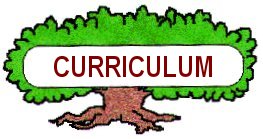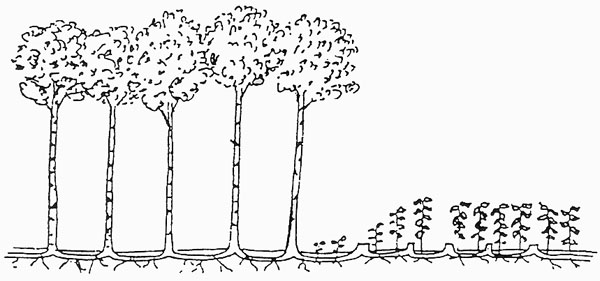

Home Page |
MICHIGAN FORESTS FOREVER TEACHERS GUIDE
| THE ISSUE OF CLEARCUTTING |  |
 |
Clearcutting
- - -
Is It Necessary? |
Clearcutting is a subject of considerable controversy throughout the nation as well as in Michigan. However, it is a legitimate forest management tool that has specific applications to meet particular objectives.
1. What is Clearcutting?
Clearcutting is a method of timber harvest and regeneration. It involves cutting all or most of the trees in an area at one time.
2. Why is it done?
Clearcutting is used as a method of regenerating or rejuvenating certain kinds of trees that cannot tolerate shade. It is also used when a forest type conversion is planned, often from low quality hardwoods to pine, on sites best for pines.
3. But why not cut only the larger ones and leave the little ones?
Almost all the trees in these shade-intolerant forests are the same age. The small ones are not necessarily young ones. Second, trees vary in their ability to grow up under the shade of other trees. Sugar maple and balsam fir, for instance, will grow well under shade, while jack pine and aspen grow very poorly in shaded situations.
4. Is clearcutting the best way to harvest all kinds of timber?
No. Although clearcutting is appropriate in some types of forests, methods that leave various numbers of trees standing are preferred and practiced in most other situations. Clearcutting may not be the best practice on certain types of soils, slopes, or other factors, even though the timber types would benefit.
5. When is clearcutting appropriate?
Let’s look at two of Michigan’s largest timber types and how clearcutting helps their growth.
v Aspens (popples). There are two species of aspens native to Michigan; quaking aspen and bigtooth aspen. They are among nature’s “pioneer trees”. That is, they are trees that will start new forests after fires, floods, windstorms, or other disturbances. Aspens tend to grow in groups called clones that are supported by a common root system. These interlaced roots will send up new sprouts, called suckers, if the trees are cut when alive and vigorous. The sprouting is stimulated by two factors; the warming of the ground by the sun due to the removal of shade, and the absence of sprout-suppressing chemicals produced in the tops of the aspen trees.
Thus, clearcutting provides two essential stimuli for development of a vigorous, new aspen stand. The cleaner the cut, the better it works. Small-diameter stems of maple and oak, if left, will develop wide spreading crowns and shade out the young aspen underneath, so they must also be cut if the objective is to start a new aspen forest.
v Jack pine is another pioneer species. This one commonly occupies some of the driest, sandiest sites in Michigan. Few other tree species can survive on these sites, while jack pine can develop into commercially valuable stands. For this reason, it may be the only choice available in many areas in northern Michigan.
Jack pine’s place in the ecological scheme of things is to restock areas after forest fires. Its cones contain a resin, which prevents them from releasing their seeds. The cones stay in the tree tops for many years where they will open if a fires sweeps through the stand. The heat melts the resin but usually passes through too quickly to burn the cones. The after the fire, the seeds fall on the freshly burned earth, a perfectly prepared seedbed. The fire has prepared the seedbed, released the seeds and destroyed the overhead shade all in one pass.
Clearcutting mimics the effects of the fire by removing the shade and scuffing the ground to prepare the seedbed. The cones will also reach high enough temperatures to melt the resin if they are within one foot of the ground. If this natural seed source does not regenerate the stand, seedlings are planted.
6. Why is it important to regenerate aspen and jack pine?
Aspen and jack pine are preferred by deer, grouse, and other wildlife as places to live and as sources of food. Timber harvest provides more than half of the wood products and jobs that are important to Michigan’s people and economy.
7. What other kinds of trees are clearcut?
Clearcutting may be useful in several other situations.
v Oak, particularly on poor soils, may be clearcut (1) if trees are mature and enough young trees 3 feet or more in height are present to establish a new forest, or (2) if trees are mature and enough stump-sprouting is anticipated to create a new oak forest, or (3) if other tree species would be planted on the site, or (4) to make openings for wildlife habitat.
v Red pine, if trees are mature and a new forest would be established by planting or by young trees already present.
v Spruce, fir, and cedar may be clearcut in strips or patches that are small enough to allow seeds to blow in from nearby trees. If deer densities are high, cedar regeneration will probably be unsuccessful.
8. If clearcutting has so many benefits, why is it controversial?
Because it is shocking to see areas abruptly changed from dense forest to treeless openings. The logging debris is unsightly, even in a well-handled job. Because the new trees take a few years to become noticeable, it is perceived as wanton destruction rather than planned renewal. Often young aspens and oaks are not recognized as trees, but are thought of as “brush”. This also contributes to the misconception that clearcutting fails to regenerate forests.
9. Can the negative aspects be mitigated?
Yes. The visual effects of clearcuts can be softened by varying the shape and by leaving certain trees or groups of trees within the clearcut opening. Many clearcuts can be made into pleasing temporary vistas in this way. Changing people’s perception of clearcutting can only be done through education.
10. Are we cutting more than we can sustain in Michigan?
No. Forest surveys done by the U.S. Department of Agriculture Forest Service have shown that we are growing nearly twice as much as we are cutting. Timber harvest is monitored by the Forest Service and the Department of Natural Resources to avoid over-cutting. Michigan’s forests are still recovering from the cutting practices of the previous century and we cannot allow that kind of over-harvest to happen again. Regular forest inventory and planning assures that Michigan’s public forests will be sustained for future generations.
 |
This website was developed and created by Michigan State University Extension for the teachers of the State of Michigan. |
Page Name:
Curriculum/SupportDocs/Clearcutting.htm